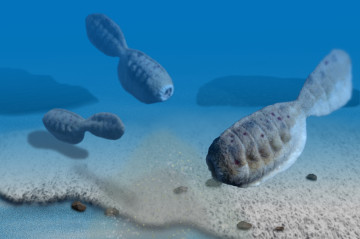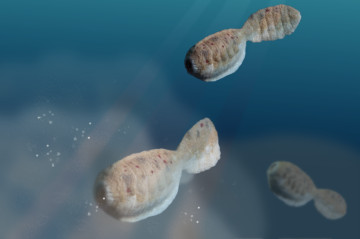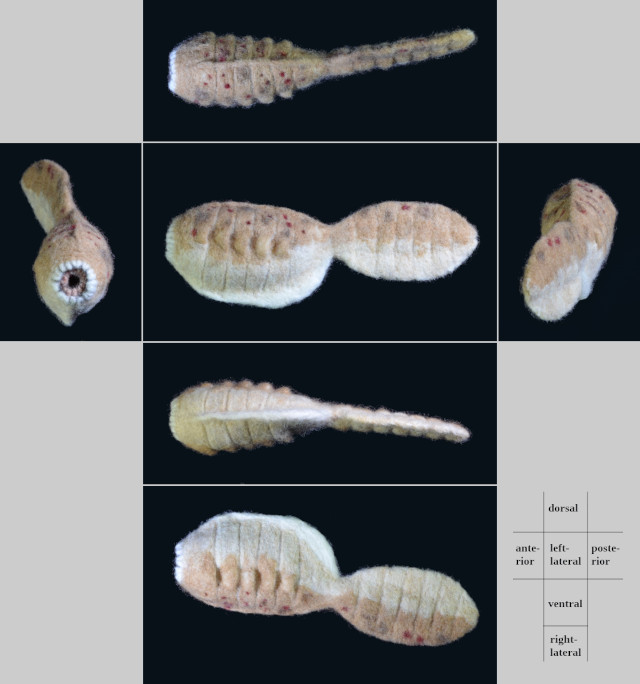Didazoon haoae
Didazoon (Didazoon haoae) has an appearance resembling a giant tadpole or a big ascidian larva, at first glance. It is an enigmatic species of the Chengjiang Fauna, and lived in the Early Cambrian sea 4).
Its generic name "Didazoon" is derived from an abbreviation of the China University of Geosciences 4). It is a member of vetulicolians (class Vetulicolida), and has a bipartite body plan, the anterior part has voluminous shape with six segments and a series of five gill-slits, the posterior part consists of seven segments 4).
Didazoon is approximately 80mm in length and about 30mm in height (measured on Figure 1d of the reference 4). Although Didazoon is resemble to Xidazoon which is also a member of family Didazoonidae, the anterior body of Didazoon is subquadrate in lateral view 1), 4). Six segmented anterior body is sac-like 1), 4), and its dorsoventral margins are flatten, especially the ventral margin is more broaded, widening posteriorly 4).
The anterior body has five gill-slits (or pouch-like gills) arraying on the midline of both lateral sides, and each slit is covered with a hood-like structure (or referred to as lappet, cawl) prominating slightly 4). Also characteristically, there is a voluminous mouth opening surrounded by a radiating oral disc at the frontal end of the anterior body 1), which should be a similar structure to those of Xidazoon.
The posterior part looks like arising from the dorsal side of the anterior. The posterior body, tail section, is an elliptic leaf shaped (the mid region is wide and the proximal and the distal end are tapered), with rounded termination. The tail part houses a gut with opening on the last segment as anus 4), 5).
Didazoon were probably epifaunal (lived on the surface of sediment), and deposit filter feeders 1), 4). Alternatively, they might have been nektobenthic (swimmers near the bottom of the sea), and suspension feeders 2). There are not any evidences or traces which are presumable as grasping or chewing mechanisms of the oral disc 1). The anterior body of the specimen is frequently filled with sediment voluminously 1), 4). Together, Didazoon would have captured deposits or supension with sea water via the oral opening, then filtered organic materials as some nutrients from them. The excess sea water may have been discharged through the gill-slits 3), 4).
Vetulicolians, which Didazoon is assigned to, have been considered to be arthropods or stem-group deuterostomes 1), 7). Futhermore, they have been interpreted variously in each taxa 1), 7). Although the possibility that the vetulicolians, including Didazoon, are protostomes still remains 1), and there are also deliberative 1), or skeptical 6) standpoints, most debates accept that the vetulicolians are deuterostomes 2), 7). However, with regard to their phylogenetic position, the debate whether they are the stem-group deuterosomes 3), 4), 5), 7), or the stem-group chordates, especially the sister group to tunicates 2) has not yet reached a conclusion.
At the present, the members of vetulicolians have not only found from China, but also from North America (the Lower Cambrian Sirius Passet in North Greenland) 7), and Australia (the Emu Bay Shale Konservat-Lagerstätte in South Australia) 2).
created in December 2020 - March 2021.
References:
- Aldridge RJ, Xian‐Guang H, Sivester DJ, Sivester DJ, Gabbott SE (2007) The systematics and phylogenetix relationships of Vetulicolians. Palaeontology 50: 131-168. (DOI:10.1111/j.1475-4983.2006.00606.x.)
- García-Bellido DC, Lee MSY, Edgecombe GD, Jago JB, Gehling JG, Paterson JR (2014) A new vetulicolian from Australia and its bearing on the chordate affinities of an enigmatic Cambrian group. BMC Evol Biol 14, 214. (DOI:10.1186/s12862-014-0214-z.)
- Ou Q, Conway Morris S, Han J, Zhang Z, Liu J, Chen A, Zhang X, Shu D (2012) Evidence for gill slits and a pharynx in Cambrian vetulicolians: implications for the early evolution of deuterostomes. BMC Biol 10, 81. (DOI:10.1186/1741-7007-10-81.)
- Shu DG, Conway Morris S, Han J, Chen L, Zhang XL, Zhang ZF, Liu HQ, Liu JN (2001) Primitive deuterostomes from the Chengjiang Lagerstätte (Lower Cambrian, China). [abstract] Nature 414: 419-424. (DOI:10.1038/35106514.) (The full-text was referred to ResearchGate.)
- Shu DG, Conway Morris S, Zhang ZF, Han J (2010) The earliest history of the deuterostomes:the importance of the Chengjiang Fossil-Lagerstätte. Proc. R. Soc. B 277:165-174. (DOI:10.1098/rspb.2009.0646.)
- Swalla BJ, Smith AB (2008) Deciphering deuterostome phylogeny: molecular, morphological and palaeontological perspectives. Phil. Trans. R. Soc. B 363:1557–1568. (DOI:10.1098/rstb.2007.2246.)
- Vinther J, Smith MP, Harper DAT (2011) Vetulicolians from the Lower Cambrian Sirius Passet Lagerstätte, North Greenland, and the polarity of morphological characters in basal deuterostomes. Palaeontology 54: 711-719. (DOI:10.1111/j.1475-4983.2011.01034.x.)





